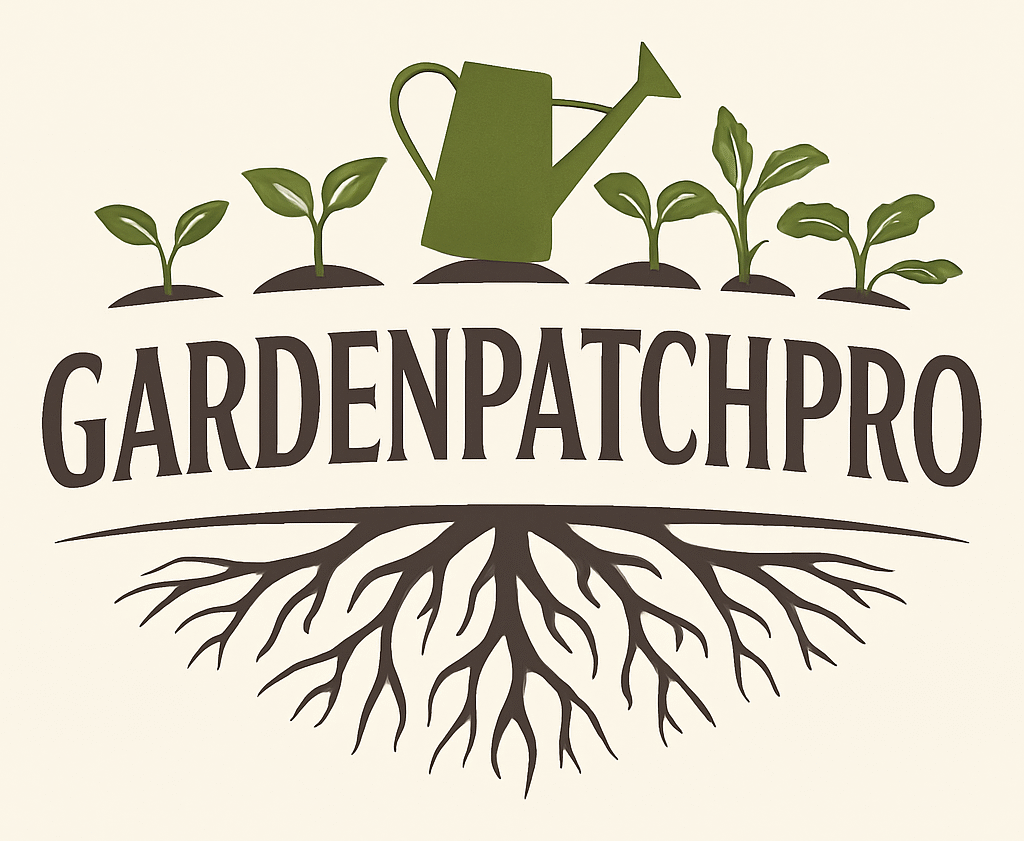How To Care For Succulents Indoors: The Essential Guide
Succulents are a great choice for indoor plants because they are low maintenance and can thrive in many home environments. The key to caring for succulents indoors is providing them with bright, indirect light, well-draining soil, and watering only when the soil has dried out completely. These simple steps create the right conditions that help succulents stay healthy and vibrant.
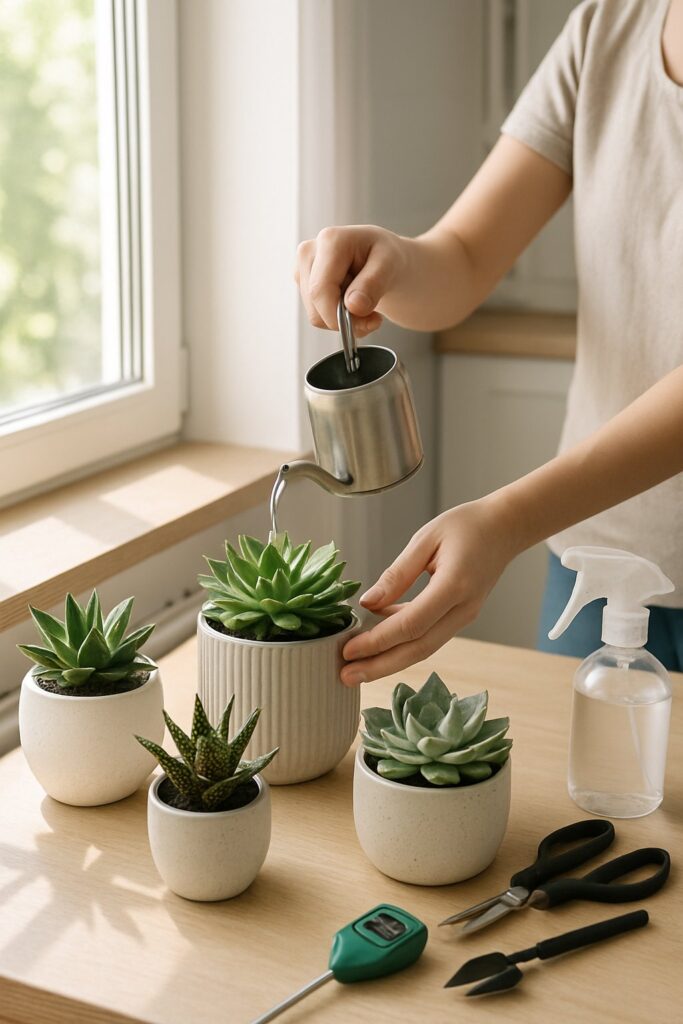
Understanding their natural habitat helps in indoor care. Succulents store water in their leaves and stems, so they need less water than other plants and can suffer if overwatered. Proper containers with drainage holes and soil that dries quickly are essential to prevent root rot.
Indoor temperatures that stay between 55°F and 75°F with low humidity usually work well. Succulents grow slowly and don’t need much fertilizer, especially in winter, but some feeding during spring and summer supports their growth. Paying attention to these factors ensures succulents will thrive inside.
Key Takeaways
- Succulents need bright, indirect light and dry soil between waterings.
- Use well-draining soil and containers with drainage holes to avoid root rot.
- Maintain moderate indoor temperatures and low humidity for best results.
Understanding Indoor Succulents

Indoor succulents are low-maintenance plants that store water in their thick leaves or stems. They come in many shapes and sizes and thrive with minimal care. Knowing what makes them special, the most popular types for indoor growing, and how they differ from outdoor succulents helps ensure they stay healthy and attractive.
What Makes Succulents Unique
Succulents are plants adapted to dry environments. Their leaves or stems store water, allowing them to survive long periods without watering. This water storage also gives them a fleshy, thick appearance.
They have a waxy coating or tiny hairs to reduce water loss and protect against pests.
Succulents grow slowly, which means they don’t need frequent fertilizing.
Some succulents, like cacti, have spines for protection, while others, such as aloe vera and jade plants, are prized for medicinal or decorative uses.
These traits make succulents ideal for indoor environments where inconsistent watering is common.
Popular Indoor Succulent Varieties
Some succulent varieties are better suited for indoor life due to their size and light needs. Common favorites include:
- Aloe Vera: Known for its healing gel, it needs bright, indirect light.
- Echeveria: Rosette-shaped with colorful leaves, prefers sunny spots.
- Jade Plant: Thick, shiny leaves; tolerates moderate light and infrequent watering.
- Snake Plant: Tall, upright leaves, low light tolerant and very hardy.
- Haworthia: Small rosettes with textured leaves, thrives in low light.
- String of Pearls: Trailing succulent with round bead-like leaves needing bright indirect light.
- Kalanchoe: Flowering succulent with thick leaves, likes bright light.
- Aeonium: Rosettes on woody stems, prefers moderate light.
These varieties vary in light, watering, and size needs, so placement and care differ slightly for each.
Indoor vs Outdoor Succulents
Outdoor succulents generally deal with more sunlight, temperature changes, and weather variations.
Indoor succulents need less intense but consistent light, usually from east or west-facing windows.
Outdoor succulents can tolerate direct midday sun; indoor ones often get sunburned if in strong direct light for too long.
Temperature tolerance differs: outdoor succulents handle cooler nights and higher heat spikes, while indoor types prefer 60–80°F and stable humidity under 60%.
Soil and watering methods are similar but indoor plants need excellent drainage to avoid root rot from overwatering.
Many succulents like agave and certain haworthia species do well both indoors and outdoors, but understanding their environment ensures long life.
For more detailed indoor care, see this complete guide to indoor succulents.
Essential Growing Conditions

Succulents need the right mix of light, temperature, humidity, and airflow to stay healthy indoors. Providing precise conditions helps prevent common problems like leggy growth or rotting.
Light Requirements
Succulents generally need bright, indirect sunlight. Most varieties do well with about 6 hours of light a day. Direct sunlight can be too strong and cause leaf burn, especially through windows.
If natural light is limited, a grow light designed for plants can supplement. Some succulents tolerate lower light levels, but they will grow slower and may stretch out.
Rotating the plant regularly ensures even growth toward the light source. For best results, place succulents near south or east-facing windows with filtered light.
Temperature Preferences
Succulents prefer daytime temperatures between 65°F and 80°F (18°C – 27°C). Night temperatures can drop but should stay above 50°F (10°C) to avoid cold stress.
Avoid sudden temperature changes or drafts from air conditioners or heaters. These shifts can cause leaf damage or slow growth.
During winter, keep succulents away from chilly window sills but ensure they get enough light. Stable, moderate temperatures support healthy roots and leaves.
Humidity and Airflow
Succulents thrive in low to moderate humidity, ideally around 30% to 50%. High humidity can trap moisture around the plant and cause root rot or fungal issues.
Good airflow is important to keep the soil drying between waterings and prevent pests. Avoid placing succulents in stagnant or overly damp rooms.
Using a small fan or opening windows can improve air circulation. Make sure the soil and pot drain well to avoid water buildup.
Soil and Containers for Indoor Succulents
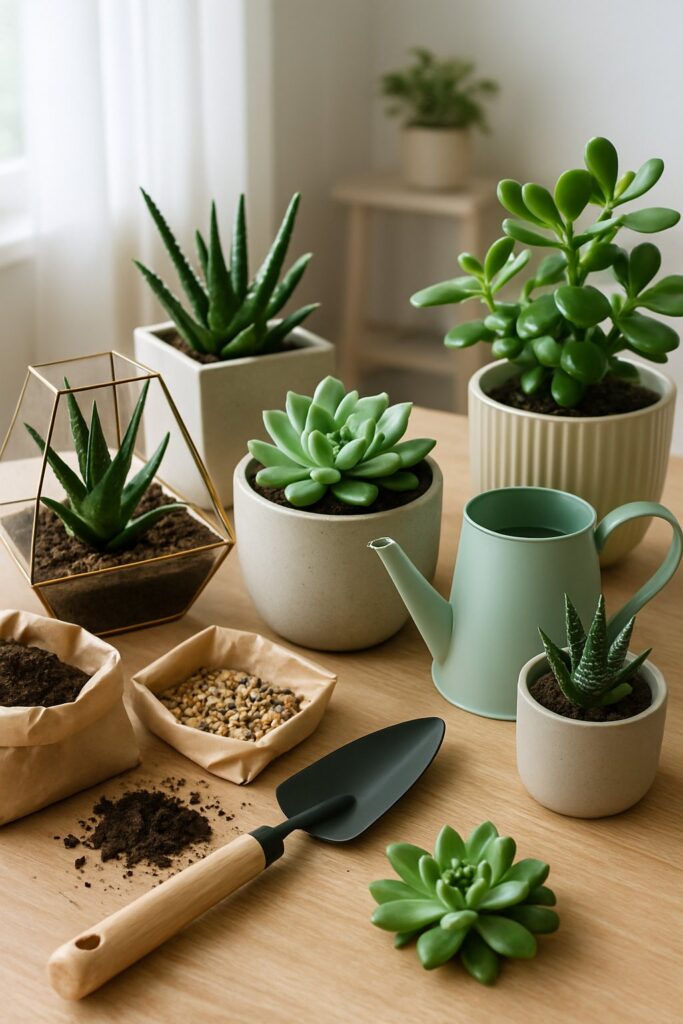
Indoor succulents need a specific type of environment to avoid problems like root rot and poor growth. This means choosing soil that drains quickly and pots that allow excess water to escape. Careful selection of both ensures succulents stay healthy and thrive indoors.
Choosing Well-Draining Soil
Well-draining soil is essential for succulents because it prevents water from sitting around the roots. Regular potting soil often holds too much moisture, which can cause root rot.
Succulent soil or cactus mix contains ingredients like sand, perlite, pumice, or small rocks. These materials help water flow through quickly while keeping some moisture for the plant to absorb. A good homemade mix might include:
- 1 part regular potting soil (without vermiculite)
- 1 part coarse sand or Turface
- 1 part perlite or pumice
Testing the soil’s drainage by watering it and watching how fast water flows through can help adjust the mix. Ideally, water should drain within 15 seconds.
Selecting Suitable Pots
The right container makes a big difference in succulent care. The pot must have drainage holes to let out extra water. Without drainage, the roots can sit in moist soil, leading to decay.
Plastic and unglazed ceramic pots can work, but not all ceramic pots drain well. Glass containers should be avoided unless used as well-ventilated terrariums since they lack drainage options.
Adding a layer of gravel or small stones at the bottom helps prevent soil from clogging drainage holes. This keeps airflow around roots and improves health.
Benefits of Terracotta Pots
Terracotta pots are a top choice for indoor succulents. These pots are porous, allowing air to flow through the sides and evaporate excess moisture. This helps keep soil on the dry side, which succulents prefer.
Because terracotta absorbs moisture, they reduce the chance of overwatering. However, they can dry out faster, so watering schedules may need adjustment.
Not all terracotta pots have drainage holes, so choosing one with holes or drilling your own is critical. Despite being heavier than plastic, terracotta’s breathability makes it the most suitable and popular option for succulent growers.
Using terracotta pots also works well for dish gardens, where multiple succulents share space but still need good airflow and drainage.
Watering Succulents Indoors

Watering succulents indoors requires careful control of moisture to keep plants healthy. The key is to avoid too much or too little water by understanding how and when to water. Monitoring the soil and plant condition helps prevent common watering problems.
Proper Watering Techniques
Succulents need deep watering that reaches the roots. Water should be applied directly to the soil, not the leaves, to avoid rot. Using room-temperature water is best to prevent shock to the roots. Watering from the top with a watering can or a bottle with a narrow spout works well.
Pots should have drainage holes to let excess water escape. Without drains, water can collect at the bottom, causing root rot. If a drain hole is missing, very small amounts of water must be used carefully.
Avoid using spray bottles or misting. Succulents store water in their leaves, so misting can cause problems. The soil should be soaked but not soggy.
Watering Frequency
Succulents should be watered only after the soil dries out completely. This usually means watering every 2 to 3 weeks in the summer. In winter, watering can be reduced to every 3 to 4 weeks because the plants use less water.
The size of the pot affects frequency: smaller pots dry out faster and need watering more often. Environmental factors like temperature, humidity, and light also matter. Warmer rooms and dry air mean more frequent watering. Cooler, humid places or low light mean watering less.
A moisture meter can help check the soil if unsure. The goal is to keep the roots moist but not wet.
Signs of Overwatering and Underwatering
An overwatered succulent shows mushy, pale, or brown leaves. The plant may look swollen or soft. Overwatering leads to root rot, which is often fatal. If caught early, watering should stop and the soil allowed to dry out.
Underwatered succulents have wrinkled, shriveled leaves that lose their plumpness. The plant may look dull and dry. If underwatered, thorough watering is needed but not too often afterward. Balance is key to good succulent care.
Knowing these signs helps adjust watering habits to keep succulents healthy and thriving indoors.
For more on watering and succulent care, visit a detailed guide to watering succulents indoors.
Fertilizing and Feeding
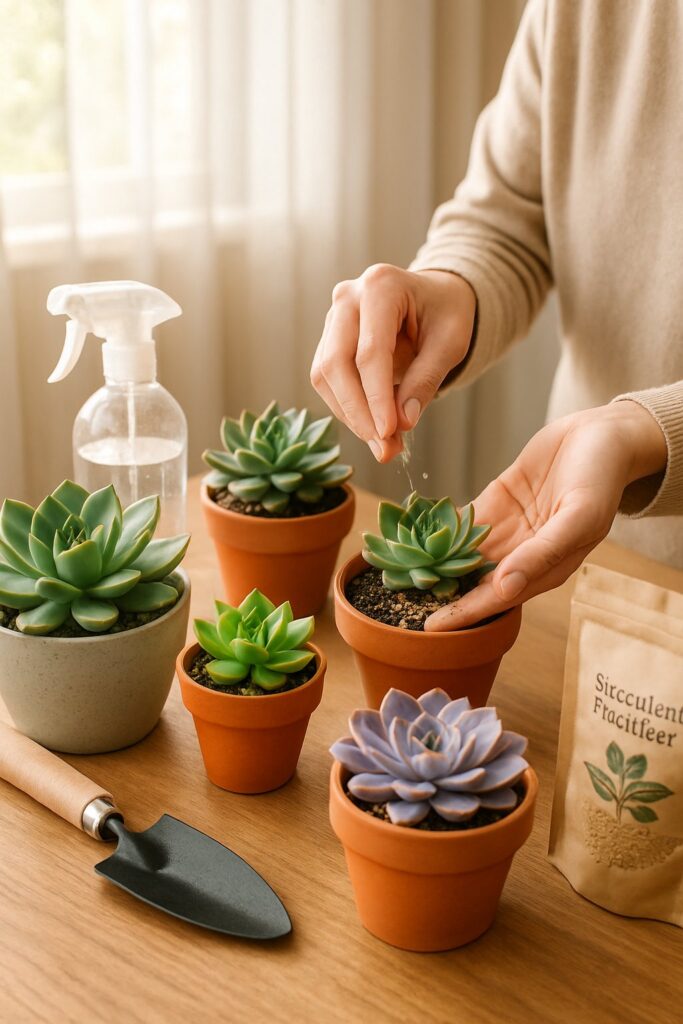
Succulents need careful feeding to grow healthy but not too often or too strong. Proper fertilizers and timing help avoid weak or damaged plants. Using the right fertilizer and feeding schedule supports steady growth without harming the succulent.
Best Fertilizers for Succulents
Succulents do best with fertilizers low in nitrogen and balanced for phosphorus and potassium. A common choice is an all-purpose fertilizer diluted to 25% strength. Special succulent or cactus fertilizers often have low ratios like 1-2-2, which prevent burning and overgrowth.
Organic options like diluted fish emulsion or manure tea also work well because they provide nutrients gently. Succulent growers should avoid slow-release fertilizers that can release too much too fast and harm the plants.
It’s important to always dilute liquid fertilizers and never fertilize dry soil. Wet the soil first to prevent root burn. A basic guideline is to use fertilizers with these N-P-K ratios:
| Type | Nitrogen (N) | Phosphorus (P) | Potassium (K) |
|---|---|---|---|
| All-purpose diluted | 8-8-8 or 20-20-20 (25% strength) | Balanced | Balanced |
| Specialized succulent | 1-2-2 or similar low nitrogen | Higher for bloom support | Balanced |
Fertilizing Schedules
Succulents should be fertilized mainly during their growing season, generally spring and summer. Feeding in dormancy, usually fall and winter, can harm plants or cause leggy growth.
Most growers recommend feeding once a month or less. Some nurseries apply very diluted fertilizer with every watering, but less frequent light feedings reduce the risk of overfertilization.
If uncertain, it’s better to skip feeding than overdo it. Watching plant growth helps decide when to fertilize—if growth slows or leaves look pale, a feeding may help. Outdoor succulents in ground usually need less fertilizer than potted plants.
Avoiding Overfertilization
Too much fertilizer causes legginess, weak stems, or early blooming that shortens plant life. High nitrogen levels lead to soft, stretched plants vulnerable to disease.
Avoid applying full-strength fertilizer directly to succulents. Use dilution (often 25% or less) and water the soil beforehand to prevent root damage.
Signs of overfertilization include yellow leaves, burnt leaf edges, and poor root health. If suspected, flush the soil with water to remove excess nutrients.
Limiting fertilizer and repotting every few years helps keep the soil nutrient balance right and reduces buildup of salts that harm succulents.
Propagation and Repotting
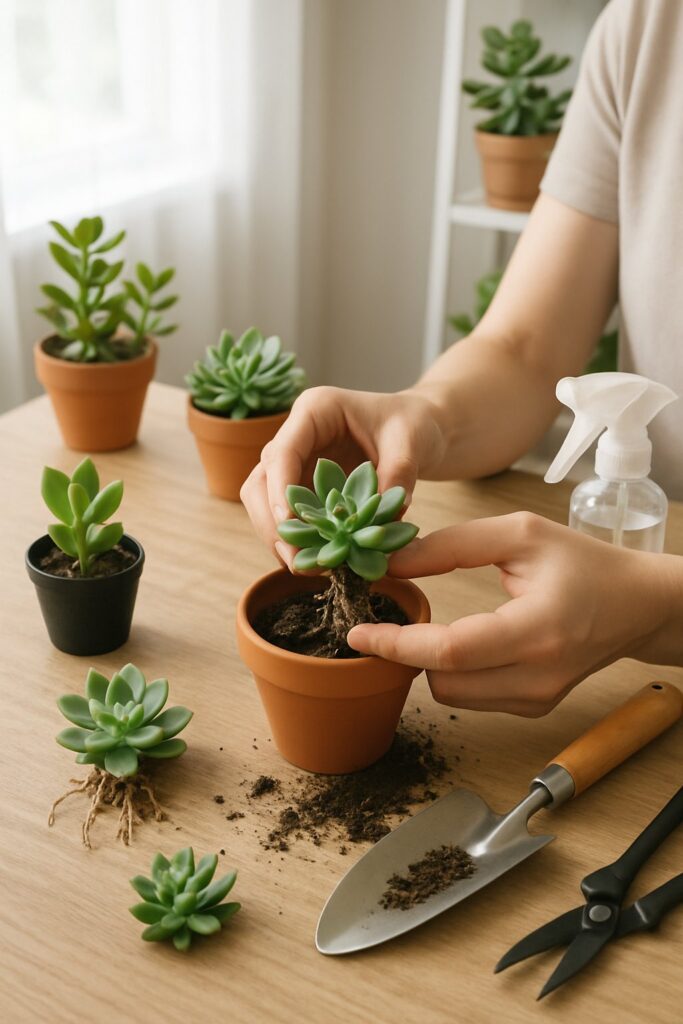
Succulents can grow and thrive longer with proper propagation and repotting techniques. These two care steps help prevent overcrowding, maintain healthy roots, and encourage new plant growth.
Methods for Propagating Succulents
Succulents are commonly propagated using leaf cuttings, stem cuttings, or offsets (small new plants that grow from the base). Leaf propagation involves gently twisting a leaf off the stem and letting it dry for a few days. Once the cut end forms a callus, place it on well-draining soil and wait for new roots to grow.
Stem cuttings require cutting a healthy piece of the stem and allowing it to dry before planting. This method works well for succulents with elongated stems. Offsets can be gently removed from the mother plant and replanted.
Propagation needs indirect sunlight and minimal watering until roots develop to avoid rot. This method allows gardeners to produce multiple plants efficiently.
Repotting Best Practices
Succulents need repotting when they outgrow their pots or the soil becomes poor. The best time to repot is during the active growing season, usually spring or early summer.
Use pots with good drainage holes and fresh, well-draining succulent soil to avoid root rot. When repotting, remove the plant carefully to avoid damaging roots. Shake off old soil and trim any dead or rotten roots.
Place the succulent in the new pot with soil covering the roots but not burying the stem too deep. Water lightly after repotting and keep the plant in a shaded area for a few days to help it adjust. Proper repotting supports healthy growth and prevents common problems like overwatering and poor airflow.
For more specific guidance, see how to repot succulents properly.
Common Problems and Solutions
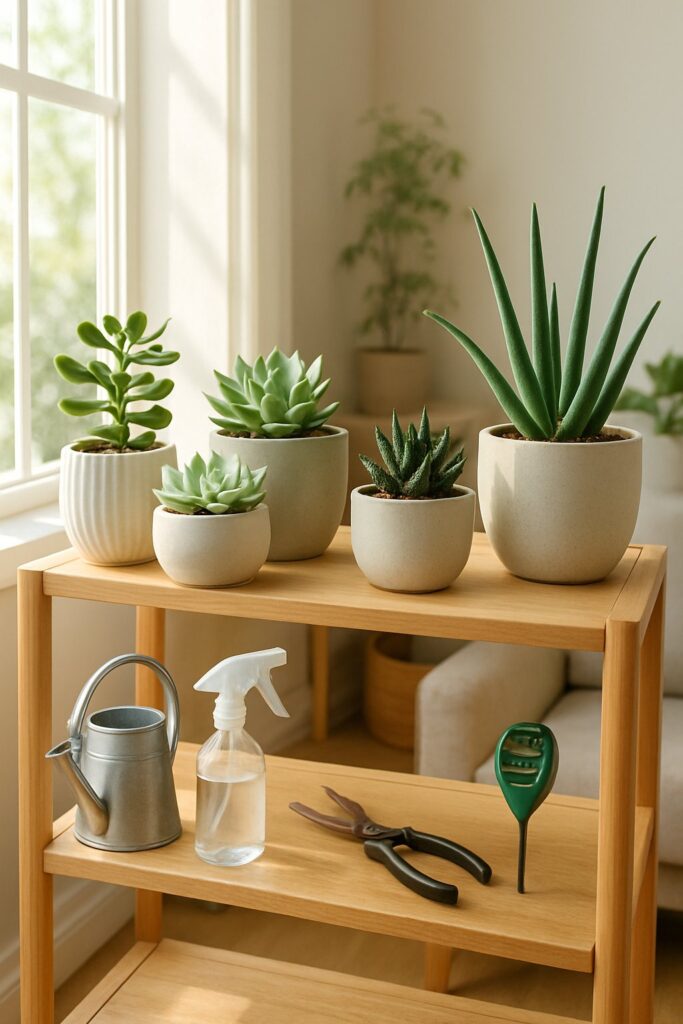
Succulents indoors can face issues like pests, root problems, and growth troubles. Identifying these early and addressing them correctly will keep plants healthy and growing strong.
Pest Prevention and Treatment
Spider mites, mealybugs, and aphids are common pests that attack indoor succulents. These pests suck sap, weakening the plants and causing yellow or deformed leaves.
To prevent infestations, maintain good air circulation and avoid overwatering. Regularly inspecting plants helps catch pests early.
If pests appear, isolate the affected plant. Use insecticidal soap or neem oil to treat infestations. For mealybugs, cotton swabs dipped in rubbing alcohol work well to remove them manually. Repeat treatments every few days until pests disappear.
Keeping plants healthy with proper light and water reduces vulnerability to pests.
Managing Root Rot and Disease
Root rot is a serious problem caused by too much water and poor drainage. Succulents need fast-draining soil and pots with drainage holes to prevent water from sitting around roots.
Signs of root rot include mushy stems, yellow leaves, and a foul smell from the soil. If detected early, remove the plant, shake off wet soil, and trim rotten roots. Repot the succulent in fresh, dry soil. Water sparingly afterward to help recovery.
Cold temperatures combined with wet soil increase disease risk. Keep succulents in warm, bright spots and avoid watering if the soil is still damp.
Troubleshooting Growth Issues
Leggy or stretched succulents happen when they don’t get enough light. The new growth becomes long and thin as the plant reaches for more sunlight.
To fix this, move the succulent to a brighter location or use a grow light. Too little light is the main cause of slow or weak growth indoors.
Leaf drop and discolored leaves can result from both under- and overwatering. Succulents prefer thorough watering followed by complete drying out of the soil.
Adjust watering habits based on the season, light levels, and soil condition to encourage healthy growth.
How To Take Care Of Succulents Indoors Tips?
Succulents need bright, indirect sunlight to grow well. Placing them near a window with filtered light helps prevent leaf burn. If natural light is limited, a grow light can support their needs.
Watering should be done sparingly. Most succulents only need water every two weeks during summer and less in winter. They store water in their leaves, so avoid overwatering to prevent root rot. It’s best to water only when the soil feels dry.
Using a pot with drainage holes is essential. This prevents water from sitting at the bottom and causing rot. Terra-cotta pots are a popular choice because they allow air to pass through the soil.
Succulents thrive in well-draining soil. Specialty cactus or succulent mixes work well. Alternatively, a mix with half regular potting soil and half coarse sand or perlite helps keep water moving away from roots.
Light feeding during spring and summer supports growth. A diluted fertilizer designed for succulents, applied about once a month, is enough. Avoid fertilizing in the fall and winter when plants rest.
Rotating pots regularly encourages even growth. Succulents grow toward light and will lean if left in one position. Turning their pots a quarter turn when watering keeps them balanced.
Watch for pests like mealybugs or spider mites. If noticed, treating plants early with alcohol on cotton swabs or organic sprays helps stop infestations without harming the plant.
For more detailed care tips, see 11 Must-Know Tips for Caring for Succulent Plants Indoors.
Frequently Asked Questions
Succulents need careful attention to watering, light, and temperature to thrive indoors. Proper care varies by season and plant type, and growing them without natural sunlight requires specific methods.
What are the best practices for watering indoor succulents?
Succulents should be watered sparingly. Most need water only every two weeks during summer and less in winter. Always wait until the soil is dry before watering again to prevent root rot.
Water should be applied directly to the soil, avoiding the leaves. If leaves look wrinkled, the plant might need more water.
How can I grow healthy succulents indoors without natural sunlight?
If natural sunlight is limited, using artificial light is important. Choose low-light tolerant succulent varieties like snake plants or ZZ plants.
Adding a grow light can help provide the light intensity succulents need. Keep them near a bright window whenever possible.
What type of artificial light is optimal for indoor succulents?
Full-spectrum LED grow lights are effective for succulents. These lights mimic natural sunlight and support photosynthesis.
Place the light about 6 to 12 inches above the plants for 12 to 14 hours daily. Avoid using regular household bulbs as they don’t provide the right light spectrum.
How should I adjust succulent care during the winter months?
Succulents need less water in winter due to slower growth. Water them very lightly or not at all if the soil remains moist.
Stop fertilizing during this time. Keep plants in a bright spot but away from cold drafts and freezing temperatures.
What’s the most effective way to take care of a variety of indoor succulent plants?
Use well-draining soil and pots with drainage holes for all succulents. Rotate pots regularly to keep growth even and prevent bending toward light.
Fertilize only in spring and summer with diluted succulent fertilizer. Repot succulents when they outgrow their containers or soil quality declines.
Is it possible for succulents to thrive indoors with limited light, and how?
Yes, by selecting low-light tolerant species and providing supplemental grow lights. Monitor plants to prevent legginess caused by insufficient light.
Use grow lights and rotate pots to maintain healthy growth. Keep watering minimal to avoid overwatering when light is low. For more details on lighting and care, see how to care for indoor succulents.
